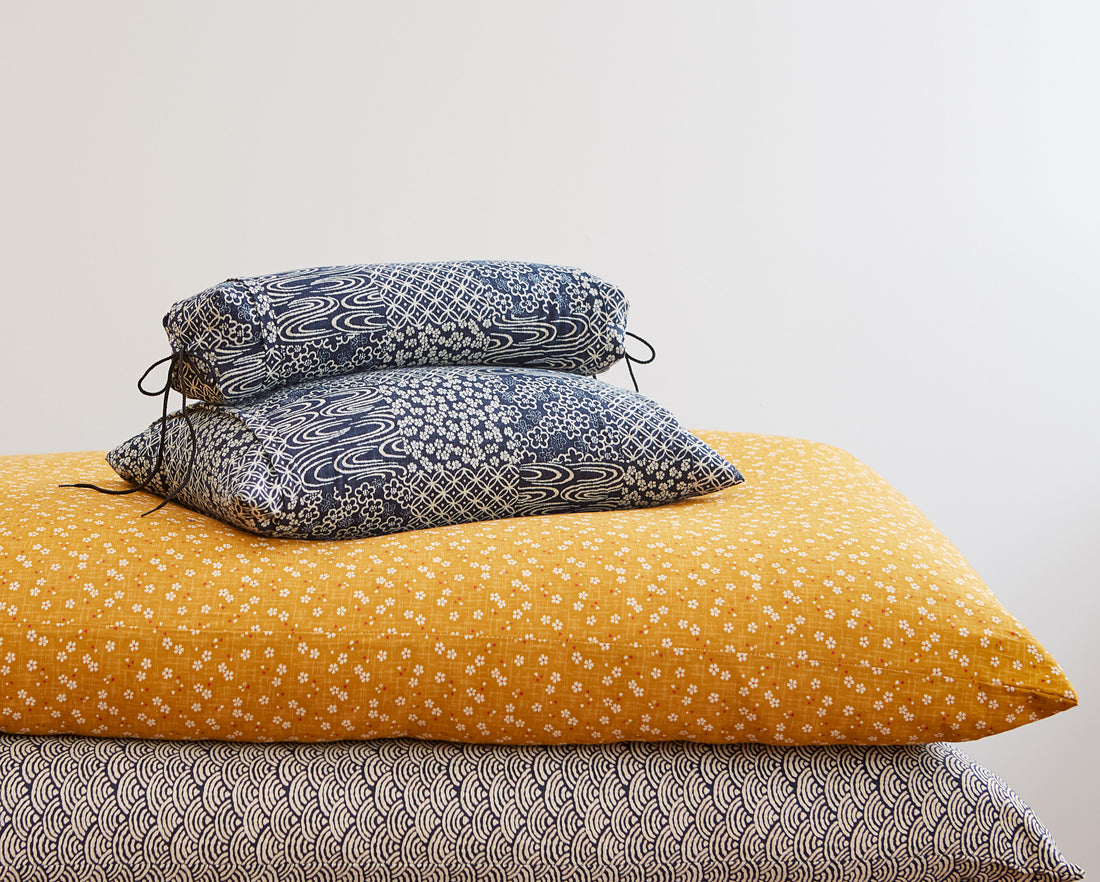The J-Life International Buckwheat Hull Pillow is carefully crafted to follow centuries worth of Japanese tradition. Use of soba gara makura (buckwheat hull pillows) dates back to the 15th century in Japan. Buckwheat hulls are the outer husks of seeds of the buckwheat plant- a type of flowering plant related to rhubarb.
Using buckwheat (sobakawa; そば皮) in pillows creates a firm yet cushioning sleep surface for your head and neck. The springy nature of buckwheat husks helps to keep your head and spine aligned no matter which way you sleep, and they do not lose shape during the night nor after continued use. Sobakawa pillows are also naturally pest resistant, hypoallergenic, and promote air circulation, which helps you keep cool and dry. These pillows are still popular in Japan today and other parts of the world in place of feather or synthetic fillings, especially for use with shikifuton mattresses.

What’s in a J-Life Buckwheat Hull Pillow?
Each Japanese buckwheat pillow is composed of a fabric outer case filled with buckwheat hulls and a removable sheath that functions like a pillowcase. They come in two styles (sold separately): the 3.5” x 15” buckwheat neckroll pillow and the 13" x 18" rectangular buckwheat pillow.
All of the fabrics we offer at J-Life are available for your soba gara makura, so you can customize your buckwheat pillows to match your shikifuton covers, kakefuton covers, and any J-Life pillowcases. We offer 100% cotton fabrics imported from Japanese textile manufacturers who take inspiration from traditional Japanese pattern design when creating these high-quality fabrics. Additionally, we offer Japanese pillows with premium 100% silk pillowcases.
The sheath on all of our buckwheat neck pillows and rectangular buckwheat hull pillows is available in the same matching fabric as the outer case, or in crisp, solid white sateen fabric (silk fabric for our silk pillows). The white sheath option is not merely a stylistic choice, as it also possesses a deep connection with Japanese culture and symbolism.
In Japan, the color white is considered sacred and is associated with purity, humility, and cleanliness. Shinto priests traditionally don white robes, especially during ceremonies, as a symbol of their piety and to honor the Shinto gods (kami, 神). For centuries, the emperor of Japan has dressed in white robes during certain ceremonies, including part of the enthronement ritual.

As with any pillows, these traditional Japanese pillows will require regular cleaning from time to time, or if there are any accidents on our around your pillow. Continue reading to learn how to properly care for and maintain your buckwheat husk pillow.
How to Clean a Buckwheat Pillow:
Cleaning the Pillowcase & Sheath:
Like all J-Life cotton fabrics, our 100% cotton buckwheat pillow cases are machine washable in cold water to prevent shrinkage. Simply slide the sheath off, then unzip the cover to remove it, and toss both in the washing machine.
Avoid combining light-colored fabrics with dark or brightly colored fabrics for the first few washes, as the colors may bleed onto the lighter ones. Both can be put in the dryer on low heat, or flat dried.
For our silk buckwheat pillows, please refer to our silk bedding care instructions.
How to Clean Buckwheat Hulls:
Since it is an organic plant material, buckwheat should never come in contact with water or be submerged in it- this can ruin the hulls by causing them to soften and lose shape, and can cause mold growth.
The best way to clean buckwheat hulls is by laying them out in the sun for a few hours. Start by carefully removing the husks from your pillow and pouring them onto a flat surface, such as a clean baking tray, then placing them in front of a sunny window or outside on a sunny day. Be sure the hulls are out of the way of children, pets, and other animals who may knock them over.
This process only needs to be done once or twice a year to maintain clean buckwheat hulls. A good way to remember to sun your buckwheat is by incorporating it into your annual spring cleaning!

What can I do if my buckwheat pillow is too soft/ firm?
After years of use, it’s expected for the buckwheat in your pillow to break down into smaller pieces, thus causing the pillow to lose its structure over time. All you need to do to fix this is either add more buckwheat or entirely replace the contents of your pillow with our loose buckwheat hulls, sold by the pound.
If you find your new buckwheat sleeping pillow or neckroll is too firm or soft, you can also easily unzip your pillow to add or remove some husks to your liking.
My buckwheat hulls got wet… what should I do?
If your buckwheat pillow comes in contact with moisture, your first step should be to remove all layers to see if the buckwheat hulls got wet.
If the buckwheat is dry, simply remove the buckwheat and wash the fabric layers following the instructions above, or hang them separately to dry out.
If the buckwheat got only a small amount of moisture in it, you can dry it in the sun following the buckwheat cleaning instructions above.
If your buckwheat comes in contact with a lot of moisture or is soaked we recommend disposing of the hulls - but don’t worry! You can order replacement buckwheat to fill your pillow with so it’ll be good as new. Unfortunately, excess moisture can ruin the shape and structure of the buckwheat husks and result in mold and mildew formation, so it’s best to not attempt to dry wet buckwheat.
